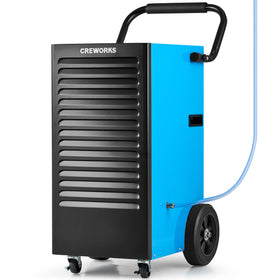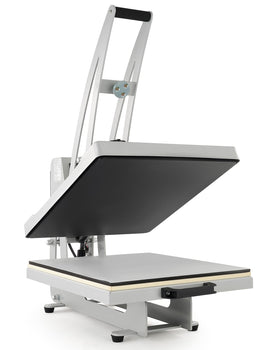An industrial water chiller plays a vital role in keeping your equipment at the right temperature, whether you’re running a high-powered laser cutter or a CNC milling machine. By circulating cooled water through the system, it prevents overheating, maintains consistent performance, and extends the lifespan of your tools. Proper installation isn’t just about getting the machine running — it’s about ensuring safety, energy efficiency, and long-term reliability. In this guide, we’ll walk you through how to install an industrial water chiller so you can set up your system with confidence.
Understanding the Water Chiller Diagram
Before diving into installation, it helps to understand your water chiller. For this guide, we’ll use the Creworks 15 Ton Air-Cooled Industrial Water Chiller as the installation example. If you’re using a different model, please make sure to read and follow the corresponding manual for accurate specifications and safety instructions. Below is the diagram that shows the key components of the Creworks machine.
How to Install an Industrial Water Chiller: A Step-by-Step Guide
Once you’ve reviewed the diagram and located each component, it’s time to start installing your industrial water chiller.
Note: Wear work gloves and other PPE necessary for your work before installation.
Step 1: Unpacking
1. Remove all packing materials.
2. Check all components and accessories for any damage during transport. If any damage is discovered, notify customer service and do not continue with installation until the product has been completely repaired.
Step 2: Selecting a Location
1. Select an appropriate location to place the chiller that meets the following conditions:
- It must be flat, stable, and able to easily bear the weight of the chiller.
- Adequate ventilation must be provided.
- It is close to the water supply, drainage, and the equipment to be cooled.
2. Use 2 or more people to transport the chiller to the selected location.
Note: DO NOT tilt the chiller more than 45° during transport.
Step 3: Completing All the Connections
1. Apply some waterproof tape to all the outlets, inlet, and port on the chiller.
2. Attach the drain valve to the drain outlet and ensure the drain valve is in the closed
position.
3. Connect the drain outlet with the valve to your drainage system with a drain hose (not
included).
4. (CWTH-8, CWTH-15, CWTH-20, and CWTH-30 ONLY) Connect the overflow outlet to your drainage system with a drain hose.
5. Connect the water fill port to the water supply with a water supply hose.
6. Fill the water tank with distilled or deionized water. For cooling carbon steel equipment,
include the appropriate amount of anticorrosive additive.
7. Disconnect the chiller from the water supply.
8. Connect the chiller’s water outlet to the water inlet of the equipment to be cooled using a water outlet hose.
9. Connect one end of the return water flow monitoring tube to the chiller’s water inlet, and then connect the other end of the tube to the water outlet of the equipment to be cooled using a water inlet hose.

Step 4: Post-Connection Checks
1. Connect the chiller to the power supply with the power cord.
2. Press the pump button to turn on the chiller and allow it to run for a few minutes.
3. Visually check for any water leaking from all the connections.
4. If there is water leaking out:
- a. Press the pump button to turn off the chiller immediately and disconnect the chiller from the power supply.
- b. Redo the connection where the leakage is.
- c. Repeat Steps 1–2 until there is no water leakage.
5. Visually check the monitoring tube to confirm whether the return water flow is sufficient.
6. If the return water flow is too small:
- a. Press the pump button to turn off the chiller immediately and disconnect the chiller from the power supply.
- b. Check whether there are any blockages in the pipelines between the water inlet and outlet, and remove any obstructions.
- c. Repeat Steps 1–2 and check again.
Note:
If you have confirmed that the return water flow is sufficient, it is recommended to remove the monitoring tube and directly connect your water inlet hose to the chiller's water inlet to prevent the plastic tube from ageing and cracking over time. After reconnecting, confirm again that there are no signs of water leakage.
Recommended Model: Creworks 15 Ton Air-Cooled Industrial Water Chiller
If you’re looking for a dependable, high-capacity unit, the Creworks 15 Ton Air-Cooled Industrial Water Chiller (CWTH-15) is an excellent choice for industrial applications.
Key highlights include:
-
Massive 53-gallon (200 L) water tank with a 95 GPM (360 L/min) flow rate for powerful heat removal.
-
22.1 HP compressor using R407C refrigerant to keep the system within 3°C of a constant temperature.
-
Cooling capacity up to 153,546 BTU/hour, providing instant and efficient cooling while minimizing water usage.
-
Clear digital display, sensors, and alarm indicators for real-time temperature monitoring and safety alerts.
This model offers both performance and peace of mind — ideal for workshops, factories, and industrial environments requiring precise temperature control.
Conclusion
Installing an industrial water chiller may seem technical, but once you understand the components and follow the manual’s steps, it becomes a straightforward process. Proper setup ensures steady cooling performance, protects your laser or CNC machine from heat damage, and helps your system run efficiently for years to come. If you’re setting up your workshop or upgrading your equipment, investing in a reliable chiller is a must. For dependable performance and precision control, consider a Creworks industrial water chiller — a trusted choice for both laser and CNC cooling applications.
My name is Michael Anderson, and I am a senior engineer specializing in heavy machinery and equipment. I hold a degree in mechanical engineering and have extensive experience in mining and construction industries worldwide. My aim is to simplify complex technical concepts, making them accessible and understandable to a wide audience.














Leave a comment